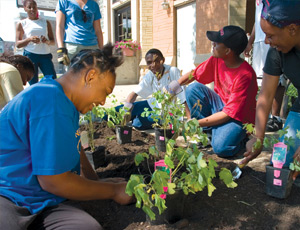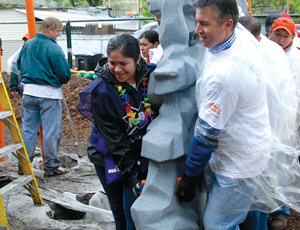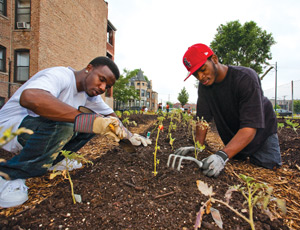- Successful community change requires
broad community participation, careful
planning that defines the community’s
vision, and a well-designed evaluation
framework.
- The Local Initiatives Support Coalition’s
New Communities Program in Chicago
uses collaborative planning to improve coordination
and accountability across stakeholders
and leverage additional resources
for higher-poverty communities.
-
The redevelopment of Murphy Park in
St. Louis, Missouri, illustrates how comprehensive
community development enacted
at the site level can be a key driver of positive
neighborhood change.

Local Chicago youth beautify East Garfield Park’s commercial district with plantings to improve the public space. Credit: LISC/Chicago, Photography by Eric Young Smith
In the late 1980s and early 1990s,
private foundations committed to
transforming disadvantaged communities
began experimenting with comprehensive
community development,
a strategy designed to promote “positive
change in individual, family, and community circumstances in disadvantaged
neighborhoods by applying the
principles of comprehensiveness and
community building to improve physical,
social, and economic conditions.”1
Broadly speaking, these efforts sought
to weave education reform, youth
development, economic development,
housing, employment, social services,
and civic participation into the fabric
of these neighborhoods.2 Although
some attempts failed, others offered
a viable roadmap for the long-term
planning, coordination, and investment
needed to build community leadership,
increase civic participation, repair physical
infrastructure, and ensure accountability
among various stakeholders.
Over the past decade, a growing body of
research has documented the strengths
and weaknesses of community transformation
and capacity-building strategies.
No definitive answers yet exist to some
of the most difficult questions about
community change. But even as the
empirical foundations for assessing such
efforts emerge — and cultivating that
body of knowledge will be a focus of
HUD-sponsored research in the coming
year — the evidence underscores
the importance of broad community
participation in effective planning, financing, and implementing community
development initiatives. The effects
of this approach can be seen both at
the city level, as illustrated by the work of the Aspen Institute and of the Local
Initiative Support Coalition’s New Communities Program in Chicago,
and at the neighborhood level, as in the development of Murphy Park in St. Louis, Missouri.

Residents and a local nonprofit collaborate to build a playground in Chicago’s Little Village neighborhood" title="Residents and a local nonprofit collaborate to build a playground in Chicago’s Little Village neighborhood. Credit: LISC/Chicago, Photography by Juan Francisco Hernandez
The Aspen Institute’s Roundtable on Community Change has been collecting
data for 18 years from a crosssection
of groups and individuals who
work to improve conditions and quality of life in disadvantaged neighborhoods. These data document the experiences
and lessons learned by these builders
of community sustainability. Aspen’s recent analysis of 43 different community
change efforts, captured in Voices
From the Field III: Lessons and Challenges
From Two Decades of Community Change Efforts, emphasizes the importance of
careful planning that defines the community’s vision, clearly specifies the
project’s objectives, deliberately aligns implementation with goals, realistically
assesses and adapts to actual capacity to
implement, and brokers the necessary partnerships and collaborations. Finally, effective planning must also include a
carefully designed evaluation framework that involves learning and making adjustments along the way.3
In Chicago, an interim assessment
of the New Communities Program
(NCP), a multiyear effort to support
community capacity building in 14
distressed neighborhoods, reinforces the importance of inclusive and collaborative
planning. Residents of each
neighborhood first engage in a structured
community planning process that
addresses each community’s unique
needs — from gentrification to crime
to education reform — and develops
projects and partnerships to address
those needs. Such neighborhood-based planning, which facilitates coordination
and accountability among the various
public, private, and nonprofit stakeholders,
is key to the program’s success. NCP’s reliance on collaborative
planning and implementation not
only builds on existing strengths and
capabilities of local groups but also
helps leverage additional resources
for heavily challenged neighborhoods.
Some NCP neighborhoods already
show increases in home prices, school
achievement, graduation rates, and
business growth.4

This victory garden in Chicago’s Washington Park neighborhood was formerly a vacant lot — an eyesore in the community. Credit: LISC/Chicago, Photography by Eric Young Smith
Murphy Park, a mixed-finance demonstration
project completed in St. Louis,
Missouri, is an important site-specific
case study of the type of comprehensive
community development that informed
the HOPE VI program. Murphy Park was created through the combined
efforts of residents, the city, the
St. Louis Housing Authority, the
state, the developer, private enterprise, and philanthropy. This rental
neighborhood of townhomes, garden apartments, and single-family homes —
with amenities, a reconstituted school,
and new, incoming investments —
replaced thousands of public housing
units concentrated within a one-mile
radius that were essentially isolated
despite being surrounded by single-family
residential neighborhoods. Notably, the Murphy Park project led to reform in the neighborhood school
that, in turn, sparked broader civic engagement in improving the Near
North Side of St. Louis, additional
investments in schools and neighborhood
improvements, and systemwide
school management reform, thus
adding to the strength and capacity
of the entire community.5
Taking lessons from both broad community
change strategies and local case
studies, policymakers at HUD are embracing
the principle of comprehensive
community planning in urban development
strategies aimed at strengthening
the capacity, resiliency, and sustainability
of entire communities. The Choice
Neighborhoods initiative in particular
will be a key strategy for strengthening neighborhoods through effective planning
and community-driven partnering.
- Karen Fulbright-Anderson and Patricia Auspos, eds.,
2006. Community Change: Theories, Practice, and Evidence,
Washington, DC: Aspen Institute, 10.
- Ibid.
- Anne C. Kubisch, Patricia Auspos, Prudence Brown,
and Tom Dewar. “Community Change Initiatives From
1990–2010: Accomplishments and Implications for
Future Work,” Community Investments 22, no.1: 8–12 and
Voices From the Field III: Lessons and Challenges From Two
Decades of Community Change Efforts, Washington, DC:
Aspen Institute, 2010.
- David Greenberg, Nandita Verma, Keri-Nicole Dillman,
and Robert Chaskin. 2010. Creating a Platform for Sustained Neighborhood Improvement: Interim Findings From
Chicago’s New Communities Program. New York: MDRC.
- Mindy Turbov and Valerie Piper. 2005. HOPE VI and
Mixed-Finance Redevelopments: A Catalyst for Neighborhood
Renewal. Washington, DC: Metropolitan Policy
Program, Brookings Institution, 18–9.
Evidence Matters Home Previous Article
|




